Submitted:
27 February 2024
Posted:
27 February 2024
You are already at the latest version
Abstract
Keywords:
1. Introduction
2. Materials
2.1. Study Area
2.2. Research Data
2.2.1. Sentinel-2 Data
2.2.2. MODIS Data
2.2.3. Elevation and Slope Data
2.2.4. Precipitation Data
2.2.5. Growth Period
3. Methods
3.1. Model
3.1.1. Selection and Grading of Impact Factors
3.1.2. Determining the Weights of Impact Factors
3.1.3. Construction of the Crop Flood Damage Assessment Index
4. Results
4.1. Extent of Flood Inundation
4.2. Crop Damage Assessment
4.2.1. Weight Determination
4.2.2. Assessment Results
4.3. Validation of the Damage Assessment Results
5. Discussion
6. Conclusion
Author Contributions
Funding
Conflicts of Interest
References
- Di L, Eugene G Y, Kang L, et al. RF-CLASS: A remote-sensing-based flood crop loss assessment cyber-service system for supporting crop statistics and insurance decision-making[J]. Journal of integrative agriculture 2017, 16, 408–423. [CrossRef]
- Tapia-Silva F O, Itzerott S, Foerster S, et al. Estimation of flood losses to agricultural crops using remote sensing[J]. Physics and Chemistry of the Earth, Parts A/B/C 2011, 36, 253–265. [CrossRef]
- Chen H, Liang Q, Liang Z, et al. Remote-sensing disturbance detection index to identify spatio-temporal varying flood impact on crop production[J]. Agricultural and Forest Meteorology 2019, 269, 180–191.
- Aerts JC, J.H.; Botzen WJ, W. Climate change impacts on pricing long-term flood insurance: A comprehensive study for the Netherlands[J]. Global environmental change 2011, 21, 1045–1060. [Google Scholar] [CrossRef]
- Bouwer, L.M. Have disaster losses increased due to anthropogenic climate change[J]. Bulletin of the American Meteorological Society 2011, 92, 39–46. [Google Scholar] [CrossRef]
- Managing the risks of extreme events and disasters to advance climate change adaptation: special report of the intergovernmental panel on climate change[M]. Cambridge University Press, 2012.
- Hirabayashi Y, Mahendran R, Koirala S, et al. Global flood risk under climate change[J]. Nature climate change 2013, 3, 816–821. [CrossRef]
- Di, S.; Guo, L.; Lin, L. Rapid estimation of flood crop loss by using DVDI[C]//2018 7th International Conference on Agro-geoinformatics (Agro-geoinformatics). IEEE, 2018: 1-4.
- Rahman, M.S.; Di, L. A systematic review on case studies of remote-sensing-based flood crop loss assessment[J]. Agriculture 2020, 10, 131. [Google Scholar] [CrossRef]
- Waisurasingha C, Aniya M, Hirano A, et al. Use of RADARSAT-1 data and a digital elevation model to assess flood damage and improve rice production in the lower part of the Chi River Basin, Thailand[J]. International Journal of Remote Sensing 2008, 29, 5837–5850. [CrossRef]
- Pacetti, T.; Caporali, E.; Rulli, M.C. Floods and food security: A method to estimate the effect of inundation on crops availability[J]. Advances in water resources 2017, 110, 494–504. [Google Scholar] [CrossRef]
- Dutta, D.; Herath, S.; Musiake, K. A mathematical model for flood loss estimation[J]. Journal of hydrology 2003, 277, 24–49. [Google Scholar] [CrossRef]
- Kwak Y, Shrestha B B, Yorozuya A, et al. Rapid damage assessment of rice crop after large-scale flood in the cambodian floodplain using temporal spatial data[J]. IEEE Journal of Selected Topics in Applied Earth Observations and Remote Sensing 2015, 8, 3700–3709. [CrossRef]
- Forte, F.; Strobl, R.O.; Pennetta, L. A methodology using GIS, aerial photos and remote sensing for loss estimation and flood vulnerability analysis in the Supersano-Ruffano-Nociglia Graben, southern Italy[J]. Environmental Geology 2006, 50, 581–594. [Google Scholar] [CrossRef]
- del Carmen Silva-Aguila N, López-Caloca A, Silván-Cárdenas J L. Damage estimation on agricultural crops by a flood[C]//Remote Sensing for Agriculture, Ecosystems, and Hydrology XIII. SPIE 2011, 8174, 126–140.
- Rouse J W, Haas R H, Schell J A, et al. Monitoring vegetation systems in the Great Plains with ERTS[J]. NASA Spec. Publ 1974, 351, 309.
- Huete A, Didan K, Miura T, et al. Overview of the radiometric and biophysical performance of the MODIS vegetation indices[J]. Remote sensing of environment 2002, 83, 195–213. [CrossRef]
- Huete, A.R. A soil-adjusted vegetation index (SAVI)[J]. Remote sensing of environment 1988, 25, 295–309. [Google Scholar] [CrossRef]
- Xiao X, Boles S, Liu J, et al. Mapping paddy rice agriculture in southern China using multi-temporal MODIS images[J]. Remote sensing of environment 2005, 95, 480–492. [CrossRef]
- Quiring S M, Ganesh S. Evaluating the utility of the Vegetation Condition Index (VCI) for monitoring meteorological drought in Texas[J]. Agricultural and Forest Meteorology 2010, 150, 330–339. [CrossRef]
- Yu G, Di L, Zhang B, et al. Remote-sensing-based flood damage estimation using crop condition profiles[C]//2013 Second International Conference on Agro-Geoinformatics (Agro-Geoinformatics). IEEE, 2013, 205-210.
- Di L, Yu E, Shrestha R, et al. DVDI: A new remotely sensed index for measuring vegetation damage caused by natural disasters[C]//IGARSS 2018-2018 IEEE International Geoscience and Remote Sensing Symposium. IEEE, 2018: 9067-9069.
- Silleos, N.; Perakis, K.; Petsanis, G. Assessment of crop damage using space remote sensing and GIS[J]. International Journal of Remote Sensing 2002, 23, 417–427. [Google Scholar] [CrossRef]
- Shrestha R, Di L, Yu G, et al. Detection of flood and its impact on crops using NDVI-Corn case[C]//2013 Second international conference on agro-geoinformatics (Agro-geoinformatics). IEEE, 2013: 200-204.
- Huang J, Wang H, Dai Q, et al. Analysis of NDVI data for crop identification and yield estimation[J]. IEEE Journal of Selected Topics in Applied Earth Observations and Remote Sensing 2014, 7, 4374–4384. [CrossRef]
- Shammi, S.A.; Meng, Q. Modeling crop yield using NDVI-derived VGM metrics across different climatic regions in the USA[J]. International Journal of Biometeorology 2023, 67, 1051–1062. [Google Scholar] [CrossRef] [PubMed]
- Galphade M, More N, Wagh A, et al. Crop Yield Prediction Using Weather Data and NDVI Time Series Data[M]//Advances in Data Computing, Communication and Security: Proceedings of I3CS2021. Singapore: Springer Nature Singapore, 2022: 261-271.
- Shrestha R, Di L, Eugene G Y, et al. Regression model to estimate flood impact on corn yield using MODIS NDVI and USDA cropland data layer[J]. Journal of Integrative Agriculture 2017, 16, 398–407. [CrossRef]
- Jongman B, Kreibich H, Apel H, et al. Comparative flood damage model assessment: towards a European approach[J]. Natural Hazards and Earth System Sciences 2012, 12, 3733–3752. [CrossRef]
- Scawthorn, C.; Flores, P.; Blais, N.; et al HAZUS-MH flood loss estimation methodology, I.I.; et al. Damage and loss assessment[J]. Natural Hazards Review 2006, 7, 72–81. [Google Scholar] [CrossRef]
- Thieken A H, Ackermann V, Elmer F, et al. Methods for the evaluation of direct and indirect flood losses[C]//RIMAX Contributions at the 4th International Symposium on Flood Defence (ISFD4). Deutsches GeoForschungsZentrum GFZ, 2009.
- Tapia-Silva F O, Itzerott S, Foerster S, et al. Estimation of flood losses to agricultural crops using remote sensing[J]. Physics and Chemistry of the Earth, Parts A/B/C 2011, 36, 253–265. [CrossRef]
- Förster S, Kuhlmann B, Lindenschmidt K E, et al. Assessing flood risk for a rural detention area[J]. Natural Hazards and Earth System Sciences 2008, 8, 311–322.
- Crow, H.A. Assessment of the FEMA HAZUS-MH 2.0 crop loss tool Fremont County, Iowa 2011[D]. University of Southern California, 2014.
- Moriondo, M.; Maselli, F.; Bindi, M. A simple model of regional wheat yield based on NDVI data[J]. European Journal of Agronomy 2007, 26, 266–274. [Google Scholar] [CrossRef]
- Mkhabela M S, Bullock P, Raj S, et al. Crop yield forecasting on the Canadian Prairies using MODIS NDVI data[J]. Agricultural and Forest Meteorology 2011, 151, 385–393. [CrossRef]
- Son N T, Chen C F, Chen C R, et al. A comparative analysis of multitemporal MODIS EVI and NDVI data for large-scale rice yield estimation[J]. Agricultural and forest meteorology 2014, 197, 52–64. [CrossRef]
- Shammi, S.A.; Meng, Q. Use time series NDVI and EVI to develop dynamic crop growth metrics for yield modeling[J]. Ecological Indicators 2021, 121, 107124. [Google Scholar] [CrossRef]
- de FSM Russo R, Camanho R. Criteria in AHP: A systematic review of literature[J]. Procedia Computer Science 2015, 55, 1123–1132. [CrossRef]
- Saaty, T.L. Decision making with the analytic hierarchy process[J]. International journal of services sciences 2008, 1, 83–98. [Google Scholar] [CrossRef]
- Jing, F. Jing, F., Yang, Y., Deng, S., et al. Simulation and Assessment of Flood Disasters. Geospatial Information 2011, 9, 122–124. [Google Scholar]
- Li M, Zhang T, Tu Y, et al. Monitoring Post-Flood Recovery of Croplands Using the Integrated Sentinel-1/2 Imagery in the Yangtze-Huai River Basin[J]. Remote Sensing 2022, 14, 690. [CrossRef]
- McFeeters, S.K. The use of the Normalized Difference Water Index (NDWI) in the delineation of open water features[J]. International journal of remote sensing 1996, 17, 1425–1432. [Google Scholar] [CrossRef]
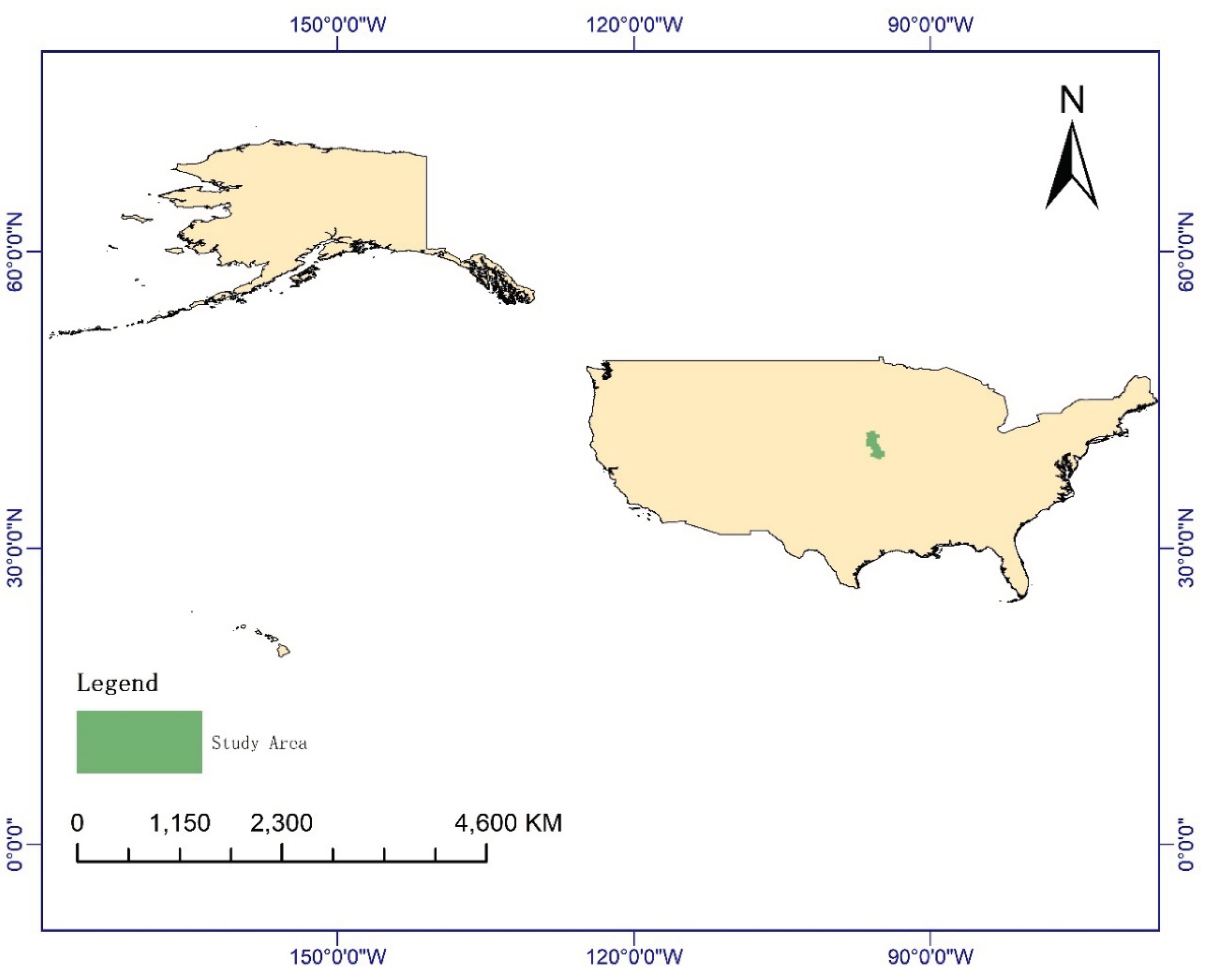
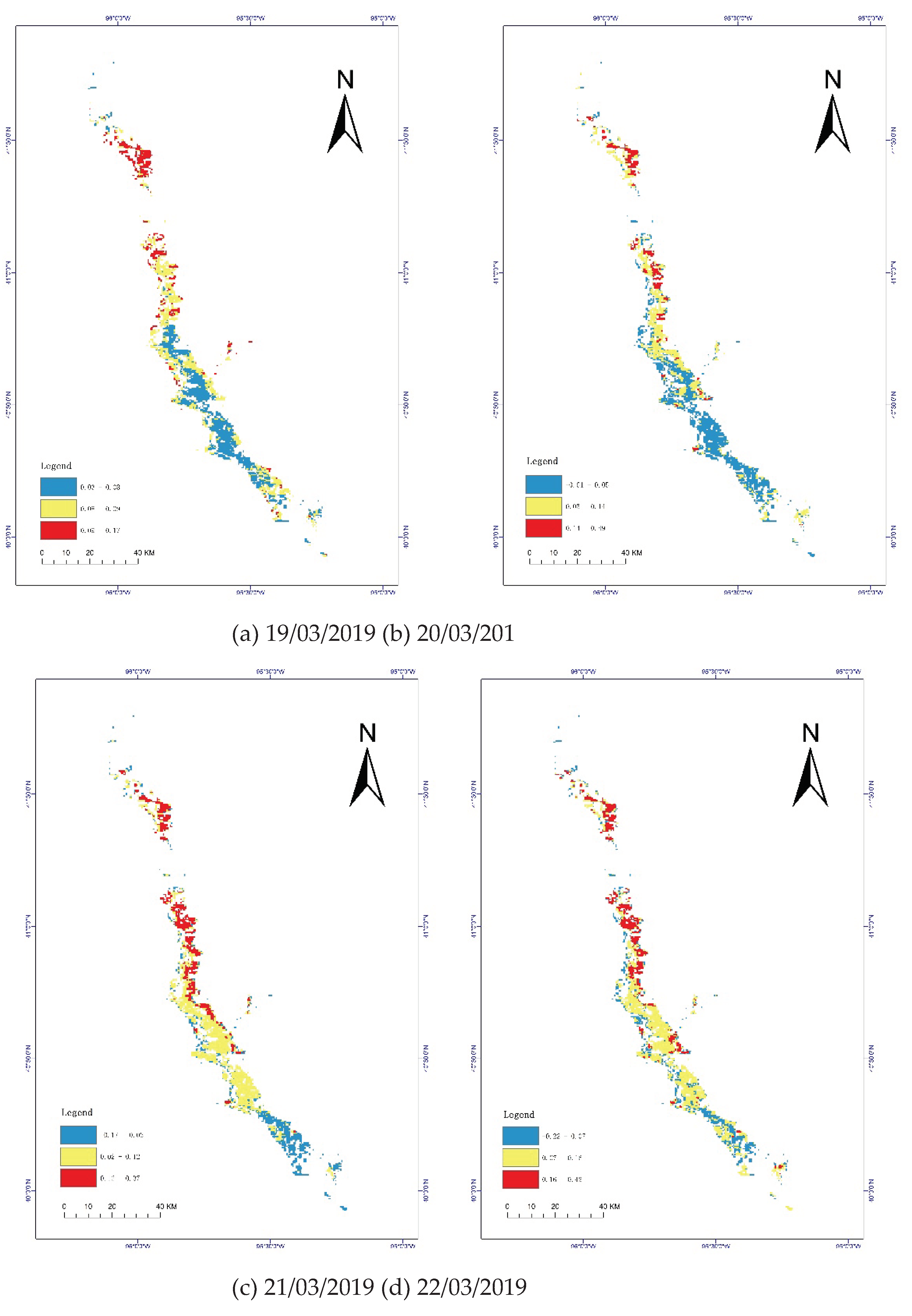
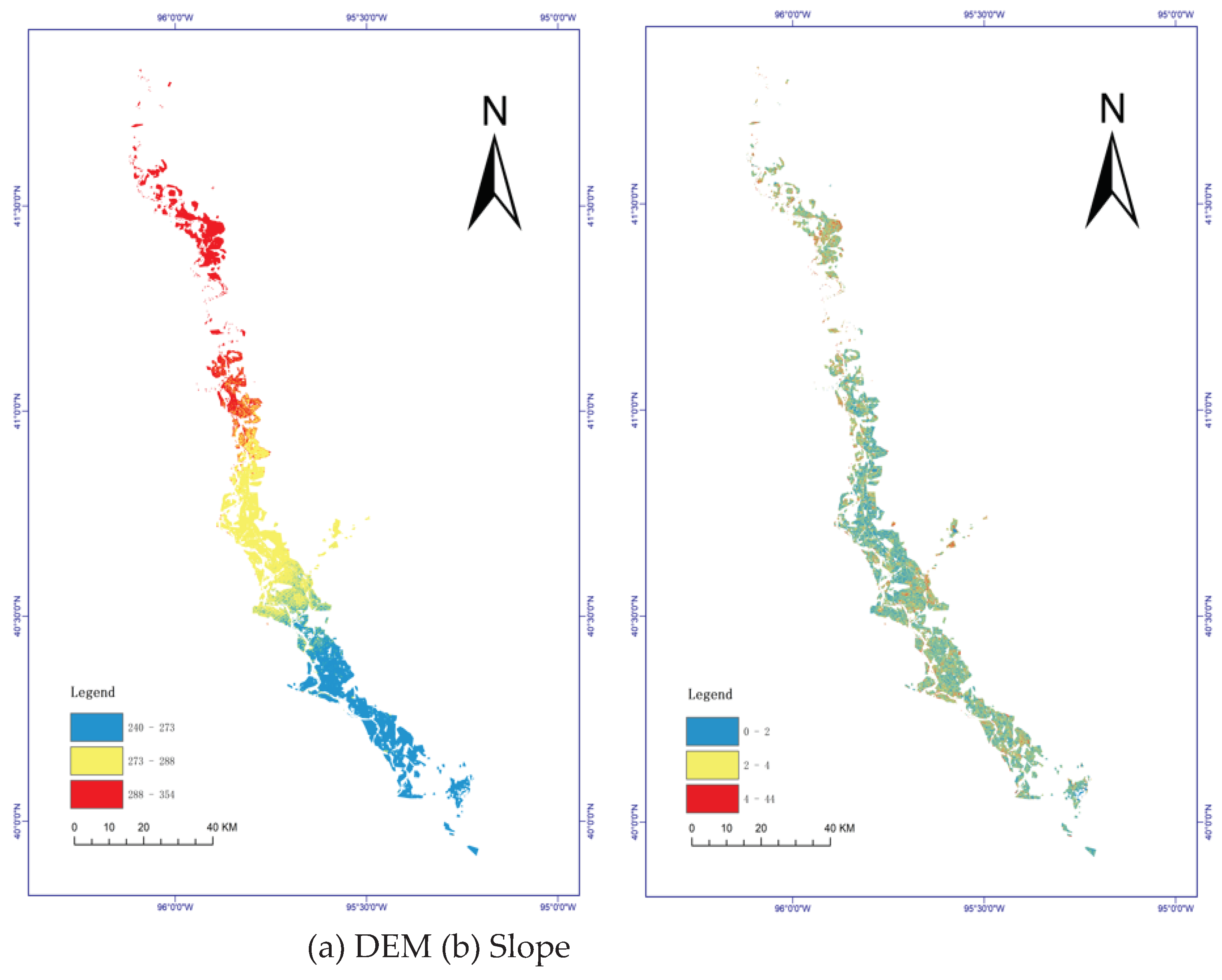
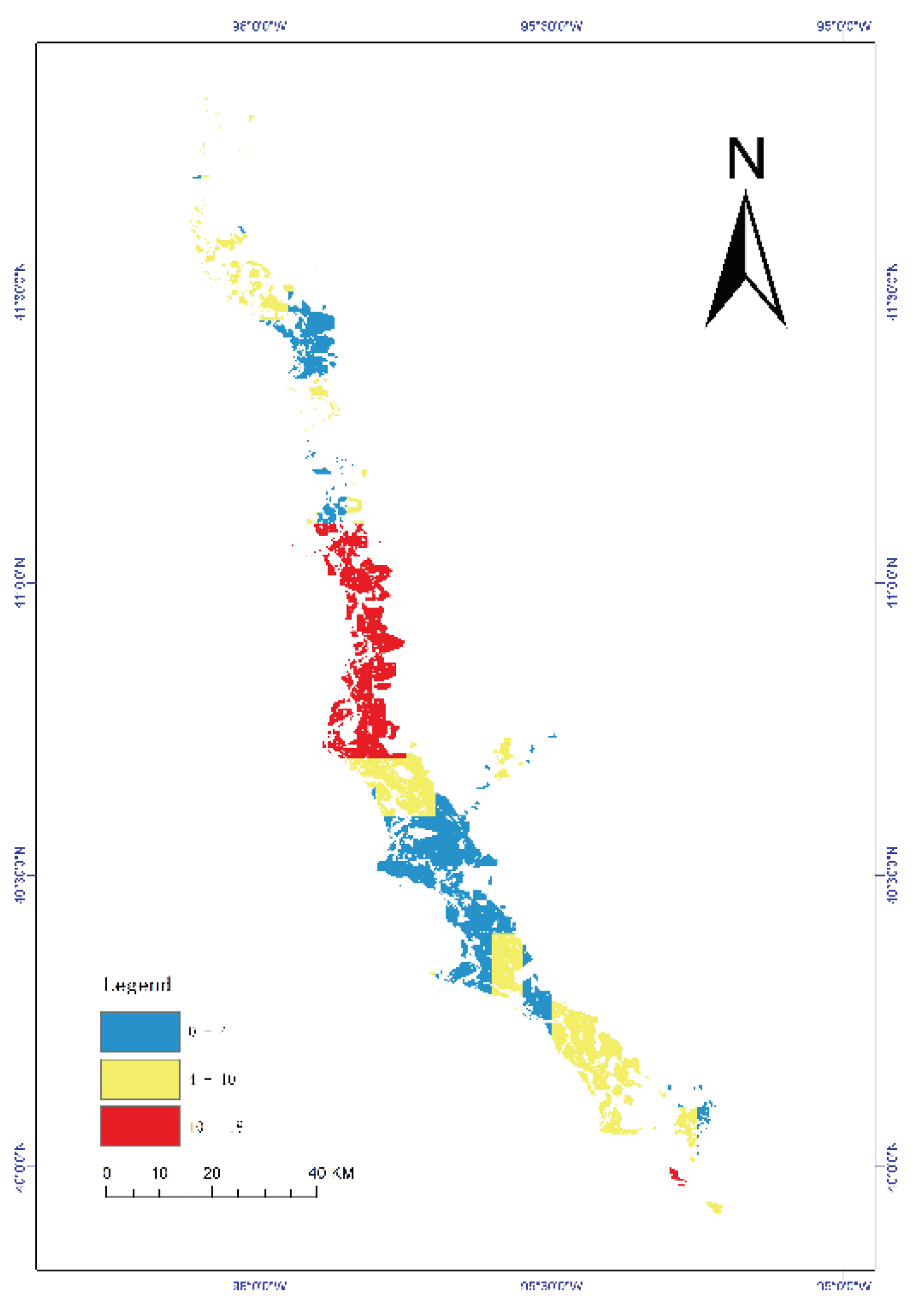
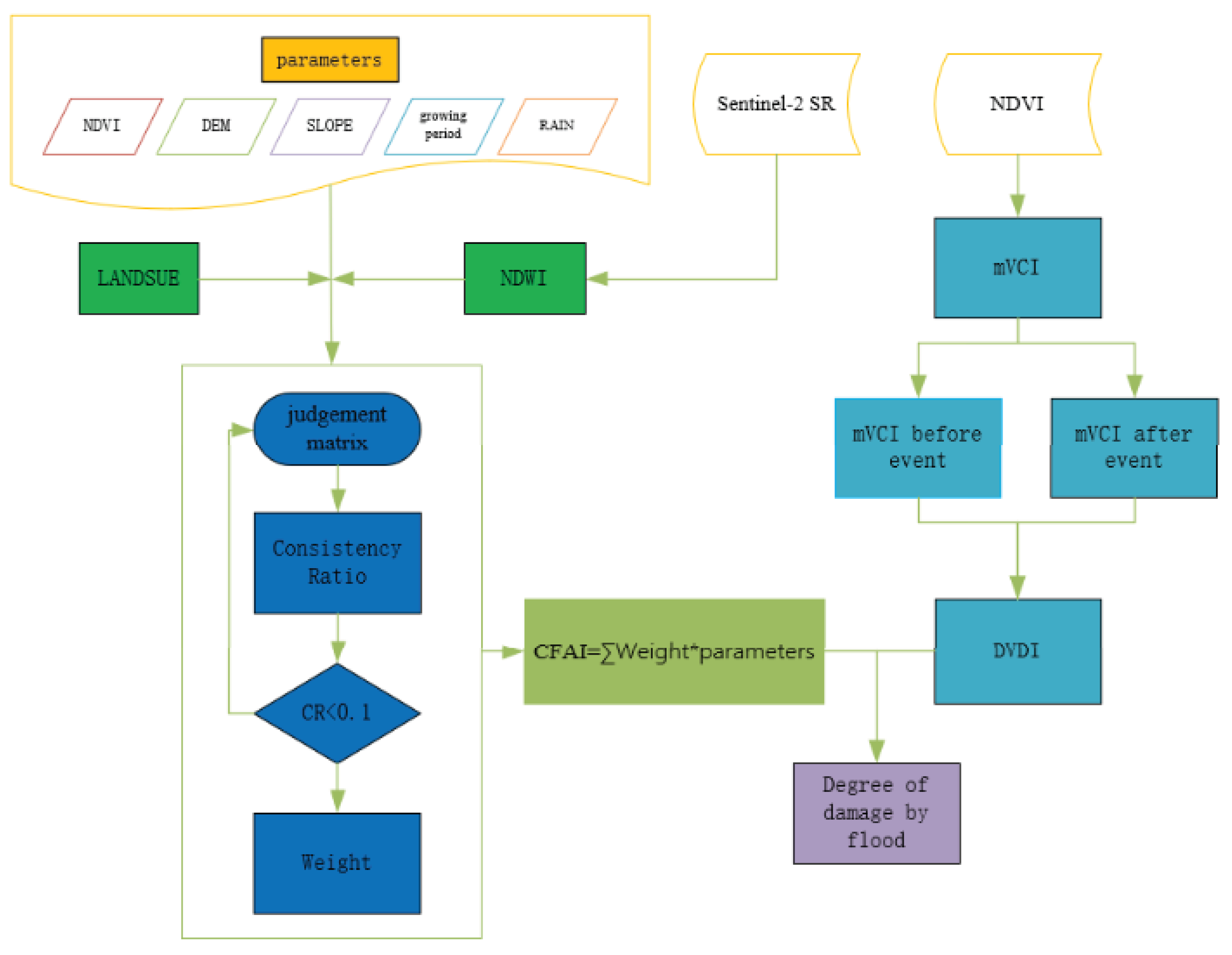
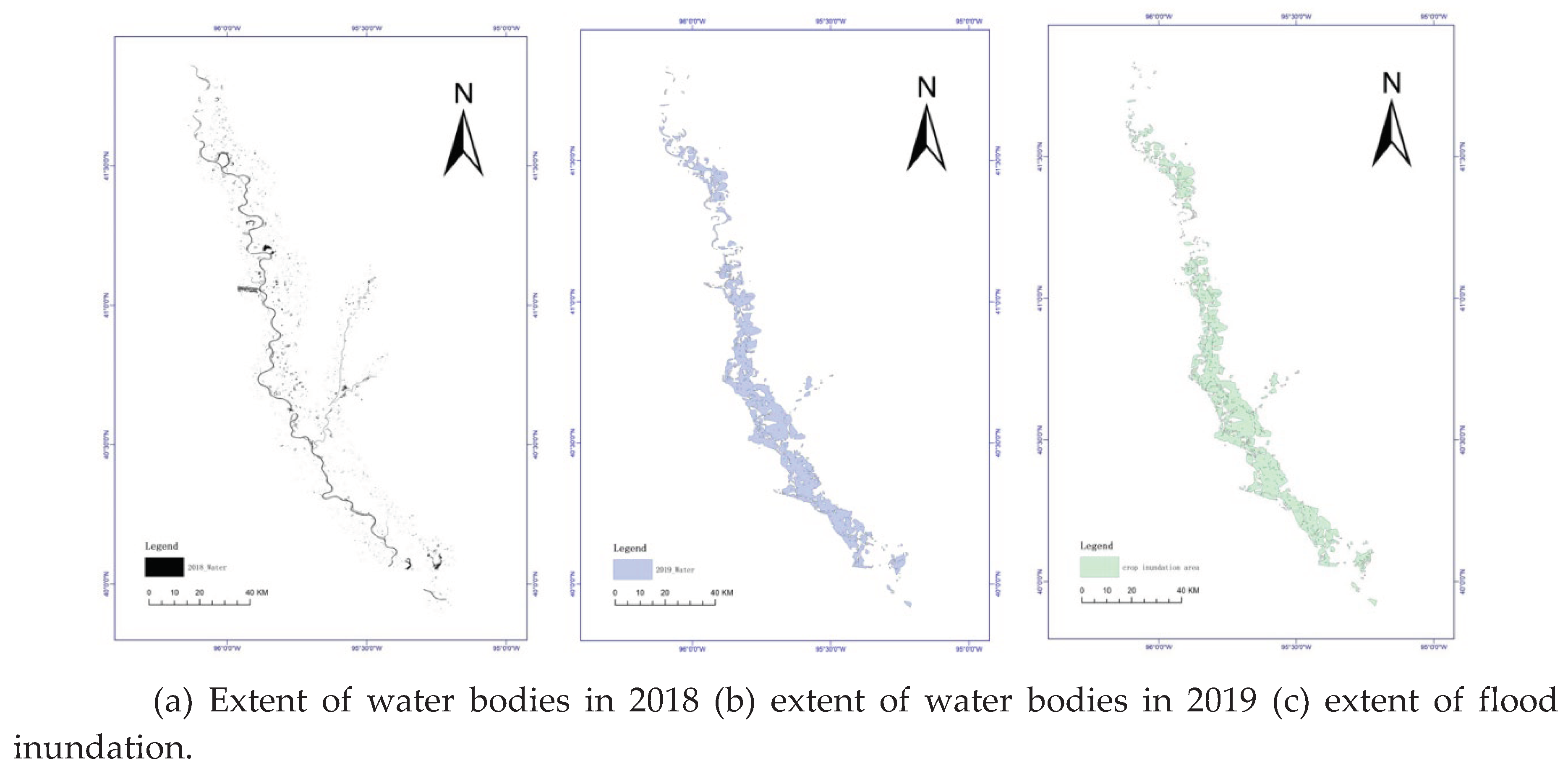
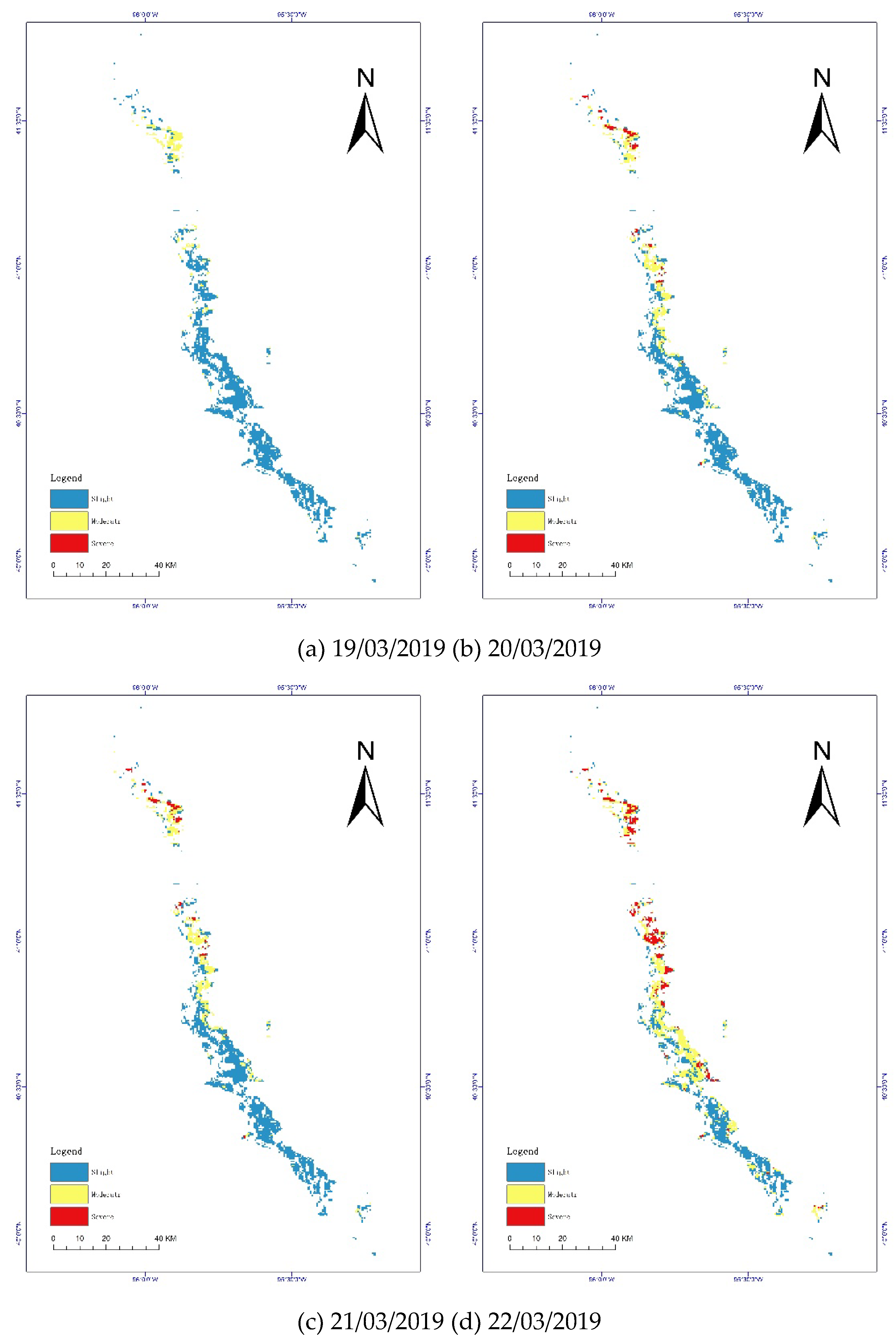
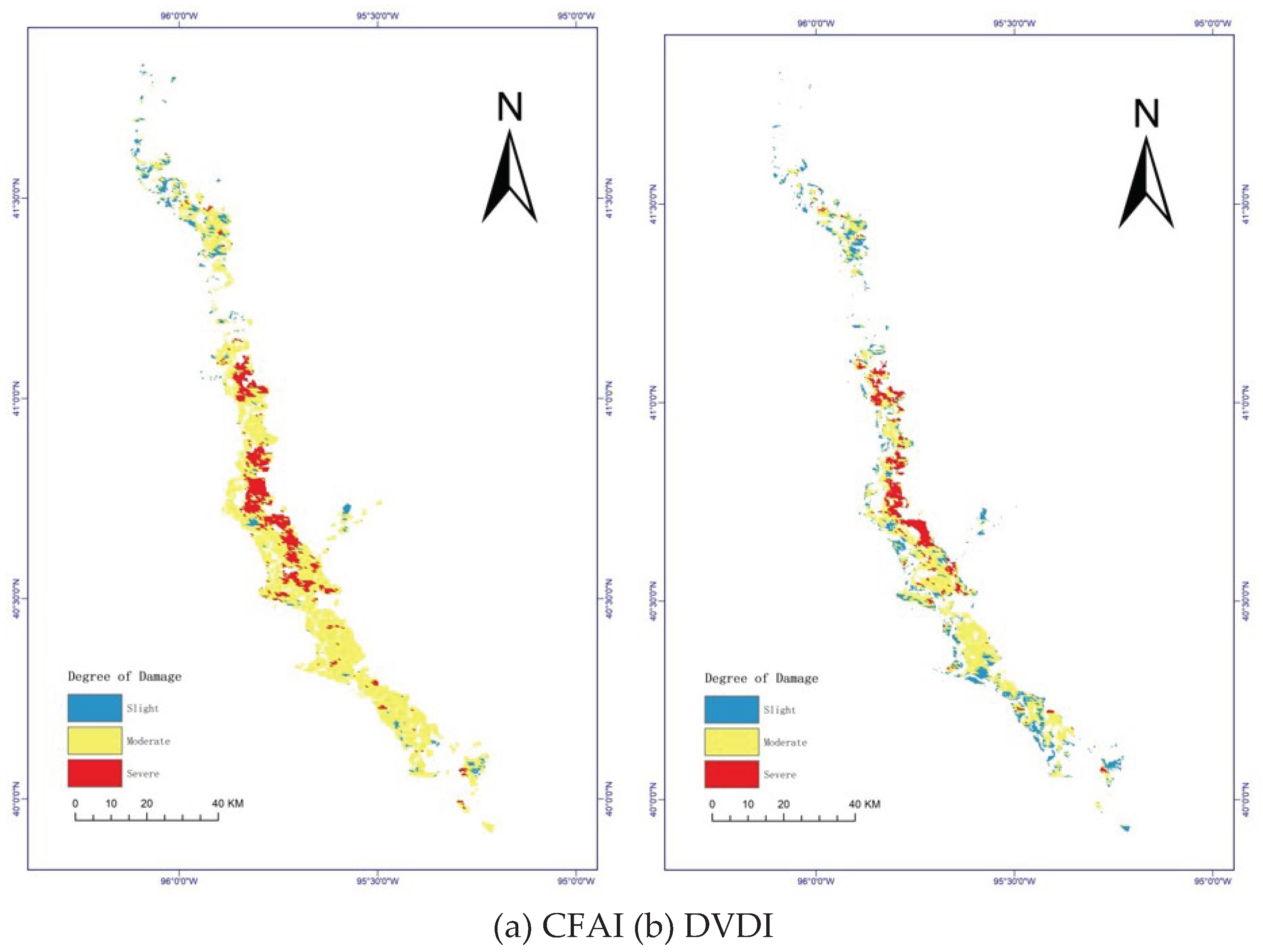
| Norm | Grading/score | ||
|---|---|---|---|
| Slight/1 | Moderate/3 | Severe/5 | |
| Change in NDVI | 0-0.1 | 0.1-0.2 | >0.3 |
| Cumulative precipitation/mm | 50-100 | 100-250 | >250 |
| Growing period | Green-up/Maturity | Grain filling/Heading | Jointing/Tillering |
| Relative elevation/m | >12 | 8-12 | 0-8 |
| Slope/degree | >15 | 5-15 | 0-5 |
| Norm | Change in NDVI | Relative elevation | Slope | Growing period | Cumulative precipitation |
|---|---|---|---|---|---|
| Change in NDVI | 1 | 4 | 4 | 5 | 6 |
| Relative elevation | 0.25 | 1 | 1 | 4 | 5 |
| Slope | 0.25 | 1 | 1 | 4 | 5 |
| Growing period | 0.2 | 0.25 | 0.25 | 1 | 3 |
| Cumulative precipitation | 0.167 | 0.2 | 0.2 | 0.333 | 1 |
| Consistency test results | ||||
|---|---|---|---|---|
| Largest characteristic root | CI value | RI value | CR value | Consistency test results |
| 5.329 | 0.082 | 1.11 | 0.074 | pass |
| AHP hierarchical analysis results | ||||
|---|---|---|---|---|
| Norm | Eigenvector | Weight (%) | Largest characteristic root | CI value |
| NDVI | 2.425 | 48.497 | 5.329 | 0.082 |
| Relative elevation | 0.973 | 19.462 | ||
| Slope | 0.973 | 19.462 | ||
| Growing period | 0.404 | 8.089 | ||
| Cumulative precipitation | 0.225 | 4.491 | ||
| CAFI | DVDI | |
|---|---|---|
| Slight | 24.9% | 7.1% |
| Moderate | 61.7% | 77.4% |
| Severe | 13.4% | 15.5% |
Disclaimer/Publisher’s Note: The statements, opinions and data contained in all publications are solely those of the individual author(s) and contributor(s) and not of MDPI and/or the editor(s). MDPI and/or the editor(s) disclaim responsibility for any injury to people or property resulting from any ideas, methods, instructions or products referred to in the content. |
© 2024 by the authors. Licensee MDPI, Basel, Switzerland. This article is an open access article distributed under the terms and conditions of the Creative Commons Attribution (CC BY) license (http://creativecommons.org/licenses/by/4.0/).





